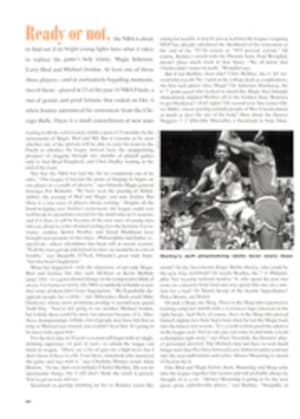
Violent Victory
Seldom has joy turned more swiftly to horror than it did after Wisconsin's 13-10 win over Michigan last Saturday before 77,745 fans at Camp Randall Stadium. The victory, Wisconsin's first over the Wolverines in a dozen years, put the 7-1 Badgers in position to win the Big Ten title and go to the Rose Bowl for the first time in 31 years, and it caused widespread jubilation, especially among the 12,000 students in attendance. But exuberance became frightening excess as many students, racing from their seats in an attempt to storm the field, formed an avalanche of humanity that rolled over two fences and everything else in its path. In the crush 73 people were injured, six of them critically.
"The crowd looked like sand running out of an hourglass," said freshman crew coach Dan Gehn, who sat in Section R, which is adjacent to the student section at the northeast corner of the stadium. In the mass exodus from the stands, many students surged through the fences separating fans from the field and advanced to the north goalpost, which, despite efforts to tear it down, remained upright. But shorter and weaker students—most of the injured were females—were crushed against the fence or trampled by those behind them.
The scene in the next few minutes was nightmarish: Ambulances sped onto the field, and paramedics performed CPR on some of the victims, several of whom lay unconscious on the turf where, shortly before, Badger tailback Brent Moss had run through the Wolverines for 128 yards on 26 carries. Moss himself, along with offensive tackle Joe Panos and several other Badger players, pulled suffocating people from the pileups that occurred near the downed fences. "It was the scariest thing I've ever seen," said the 6'3", 290-pound Panos, who was caught by national TV cameras weeping as he helped injured students. Madison mayor Paul Soglin, a former Wisconsin student, said he had seen such spectacles only in "news footage" and then "mostly from soccer games in other countries."
How could this have occurred at a college football game? Certainly, mob psychology was involved; Indiana University social psychologist Edward Hirt told the Wisconsin State Journal that because of the "de-individualism" that can occur in large gatherings, students had been emboldened to do as a crowd what they wouldn't have done alone. Then, too, this was Halloween weekend, a major party time at many colleges. Drinking was probably a factor, though not as much of one as might otherwise have been the case, authorities agreed, because the game started at 11:30 a.m., discouraging a lot of pregame boozing. "There are 77,000 opinions about what happened," said the university's police chief, Susan Riseling.
Clearly, the postgame stampede wouldn't have happened save for the stunning success of the Badger football team coached by Barry Alvarez. Wisconsin is unaccustomed to athletic glory—the collapse of the football team in the late 1980s (six wins in three years under former coach Don Morton) nearly plunged the athletic department into bankruptcy—and the win over longtime Big Ten power Michigan was more glory than some Badger followers could take.
Also caught off guard, some observers say, were campus police. There were 65 officers on duty, 10 more than usual. Still, questions have been raised about Riseling's security arrangements, especially considering the confluence of the big game, Halloween and even a full moon.
"Our goal today is to prevent injuries to people, officers, band members and fans," Riseling said in a written pregame directive to security personnel. The police should "discourage" fans from coming onto the field, she added, but "if large numbers of people begin to push through, the officer should step aside and fall back." Then, after the game began and she sensed the mood of the students as a Wisconsin victory seemed more and more possible, Riseling sent word to her troops to let students go onto the field because the police were so outnumbered. "There are not enough police in all of Dane County to handle 12,000 surging people in that section," she later explained.
Still, some students later said that the police had acted belligerently until they were literally overrun. "We would get pushed to the front, and the security would physically hit us and push us back," freshman Michael Stefanski told the Milwaukee Sentinel. "If [the police] had done all they said they planned to, allowing students to go onto the field, I think a lot of the injuries would have been averted."
There were also complaints about the configuration of 77-year-old Camp Randall and about the fact that the students—who have no assigned seating—are crammed into Sections M, N, O, P and Q, which rise like a pizza slice from ground to top level and have a very narrow access to the pedestrian area encircling the field. And what of the fences? In the face of the student onslaught, they served only to trap people.
Another potentially emotional game, a showdown against unbeaten Ohio State that could determine the Big Ten championship and Rose Bowl bid, is coming up at Camp Randall this Saturday, and Wisconsin officials said they were awaiting a report on last week's disturbing events before deciding what new security measures are necessary. Ultimately, of course, there's no avoiding the conclusion that it's the students themselves who were most to blame for the mob scene after the Michigan game; they're the ones who stormed the field. It's no excuse that unruly crowd behavior is well rooted at Wisconsin, going back at least to the Vietnam War years, when some of the antiestablishment demonstrations were led by none other than the current mayor, Soglin. Add to that the Wisconsin school's long-established reputation for partying and irreverence. Consider that in 1979 the Badger band and fans stormed the field at an away game against Michigan State, a 55-2 loss; tore down the goalpost; and paraded around while chanting, "We scored first!"
Indeed, there was so much hooliganism in the student section at Wisconsin games in the '80s—body-passing, drinking, slingshot-firing and the like—that the then director of university police, Ralph Hanson, set in motion a number of security changes. "When police routinely remove, on average, more than a hundred persons from the Stadium during each home game, something is obviously wrong," Hanson wrote in a report. Frisking spectators for hidden containers of alcoholic beverages, video-monitoring activity in the stands, and issuing summonses helped. So did continually lousy teams, which held down attendance. Alvarez's success in his four years as coach has changed that, and the Wisconsin dean of students, Mary Rouse, says what happened Saturday was unlike anything from the troubled '80s. "It was like a split second of dominoes," said Rouse, who attributed the chaos to exhilaration at the victory and pent-up tension.
One of those swept up in the surging masses on Saturday was Andrew Peissig, a coxswain on the freshman crew team. "There was absolutely nothing I could do," he said afterward. "I was moved down the stands. I'm only 5'6", 123 pounds, and sometimes my feet were off the ground. I was having trouble breathing, and then, down at the bottom, I started getting squished." Some of Peissig's crew buddies pulled him to safety, but he will never forget how he felt. "You couldn't hear anything, and then you'd hear someone screaming," he said. "It was terrible." Fortunately, by Monday no one remained in critical condition.
It was Parents Day at Wisconsin last Saturday, and some mothers and fathers looked across the field at the sea of churning students, in which, in some cases, their own offspring were being trampled. It was indirectly to those parents that Paul Wertheimer, a crowd-control consultant in Chicago, spoke when he told the Wisconsin State Journal that "the real issue here was the failure of fans, as individuals and a group, to understand what impact these actions would have." He added, "They understand it now."
TWO PHOTOS
CHRIS CORSMEIER/AP
The sight of gleeful Badger players gave way to scenes of trampled fences, wounded students and their anguished cries for help.
PHOTO
STEVE APPS/APPLETON POST-CRESCENT
[See caption above.]
PHOTO
ROBERTO BOREA/AP
Creatures from the student section mounted a goalpost, which withstood the assault.
PHOTO
BUCK MILLER
[See caption above.]
PHOTO
RICK PHILLIPS/JANESVILLE GAZETTE
As medical assistance arrived, the Badgers' triumph no longer seemed so important.
PHOTO
JOSEPH W. JACKSON III/WISCONSIN STATE JOURNAL
[See caption above.]

